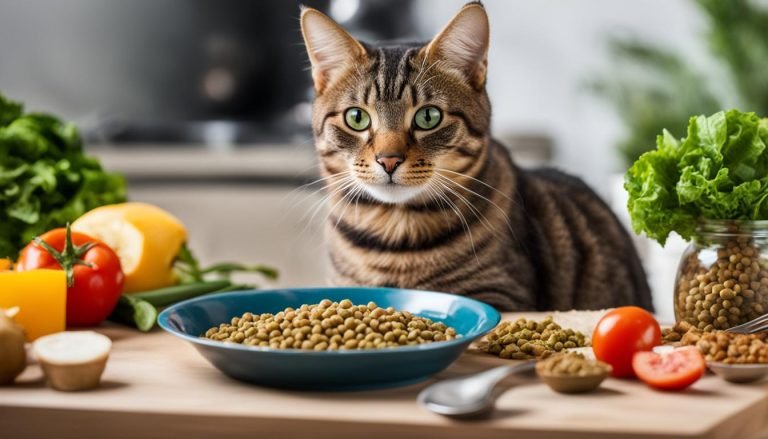What do Snakes Eat? Snake Diet Explained
Greetings!
Have you ever stopped to think about what snakes eat? I was curious about this myself, and I decided to do some digging.
What I found was fascinating! Snakes have a unique and diverse diet, with different species consuming different types of prey.
Snake Quiz
How well do you know snakes? Test your knowledge below!

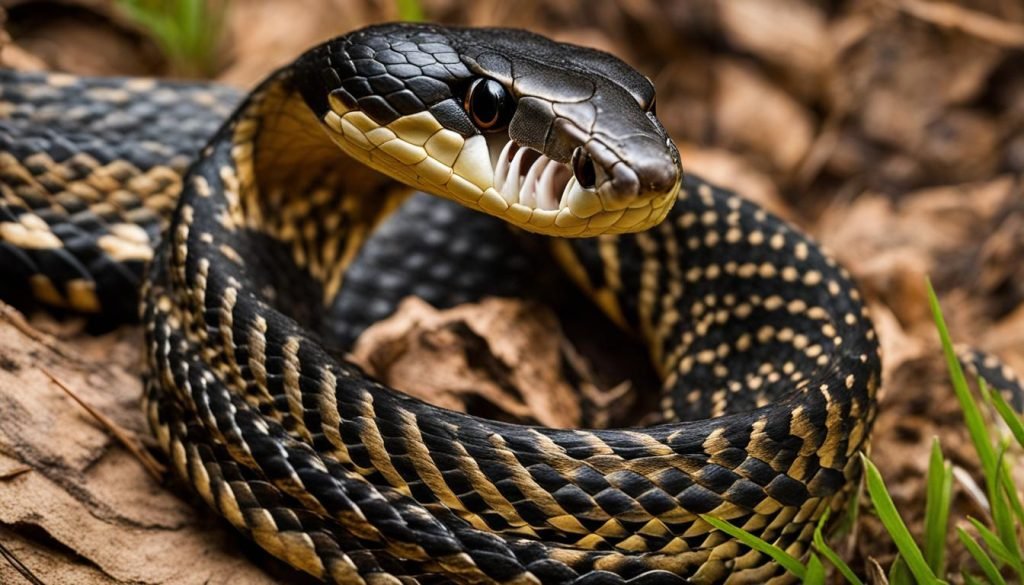
Key Takeaways:
- Snakes have diverse eating habits depending on their species and habitat.
- Understanding snake food preferences gives us insight into their role in the ecosystem.
- Snakes have remarkable adaptations to capture and consume their prey.
- Snake diets play a crucial role in maintaining the balance of ecosystems worldwide.
- Snakes kept as pets have specific dietary needs.
Snake Diet in the Wild
Have you ever wondered what snakes eat in the wild? Let me satisfy your curiosity by exploring the snake diet, including their feeding habits and the types of food they consume.
What Do Snakes Eat?
The snake diet is diverse, ranging from insects to large mammals. Depending on the species and location, snakes may be carnivorous, herbivorous, or omnivorous.
Most snakes are carnivorous, and their diet mainly consists of rodents, birds, fish, and amphibians. Larger snakes, such as pythons and boas, may also consume other snakes and small mammals, including rabbits and deer.
Feeding Habits
Snakes are opportunistic predators and use a range of strategies to capture their prey. For example, some snakes, like vipers, ambush their prey, while others, such as cobras, actively hunt them down. Some snakes use venom to immobilize their prey and make it easier to consume, while others, like constrictors, suffocate their victims by coiling around them tightly. Snakes can also go for months without food, making them adaptable to scarce resources.
The Types of Food Snakes Consume
| Food Type | Examples |
|---|---|
| Rodents | Mice, rats, voles |
| Birds | Sparrows, finches, quail |
| Amphibians | Frogs, toads, salamanders |
| Fish and Reptiles | Tuna, eels, lizards, other snakes |
As you can see from the table, snakes have a varied diet and play a significant role in maintaining the delicate balance of ecosystems.
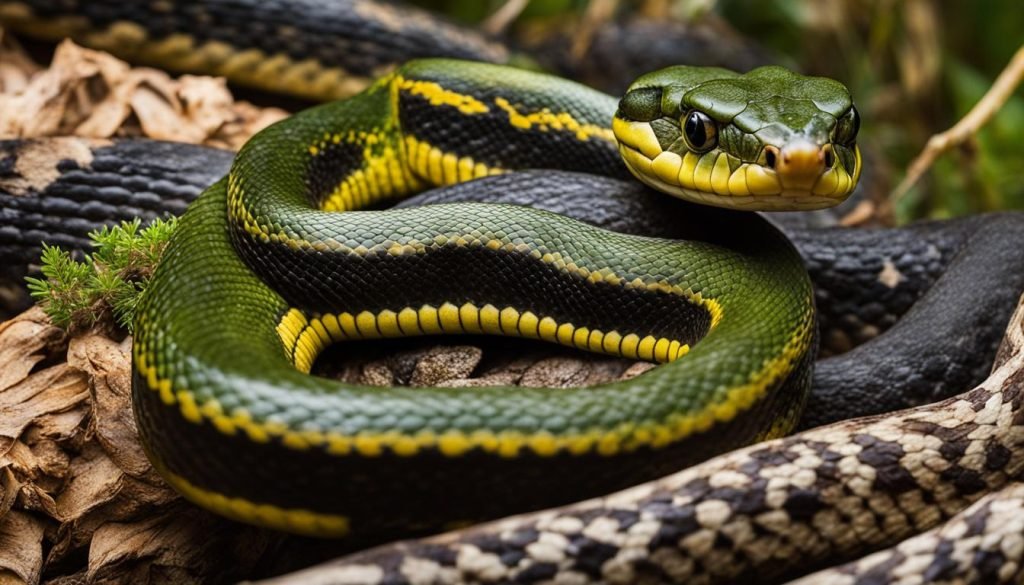
Snake Food Preferences
Snakes have a wide range of food preferences that vary according to their species and habitat. As a result, their diets are diverse and often surprising. For example, did you know that some snakes consume birds and their eggs, while others are known to eat other snakes? Let’s explore the fascinating world of snake food preferences.
“The amount and type of food that snakes consume depend on their species and size, as well as their environment and hunting techniques.”
To gain a better understanding of snake food preferences, it’s essential to examine the types of food that snakes commonly consume. These include:
- Small mammals, such as rodents and rabbits
- Birds and their eggs
- Reptiles, such as lizards and other snakes
- Amphibians, such as frogs and toads
- Invertebrates, such as insects and spiders
The amount and type of food that snakes consume depend on their species and size, as well as their environment and hunting techniques. For example, small snakes may feed primarily on insects and other invertebrates, while larger snakes may prefer larger prey, such as rodents or birds.
Snakes have unique adaptations that enable them to capture and consume their prey. For example, constrictors use their powerful muscles to suffocate their prey, while venomous snakes inject venom into their prey to incapacitate them.
Snakes and their Food
Snakes play an essential role in their ecosystem by controlling populations of rodents and other small mammals. By preying on these animals, they help to maintain the balance of nature and reduce the risk of disease transmission to humans.
Understanding snake food preferences and feeding behaviors is crucial for ensuring their survival in the wild and in captivity. As snake enthusiasts and pet owners, we can provide appropriate diets and feeding schedules that support their health and well-being.
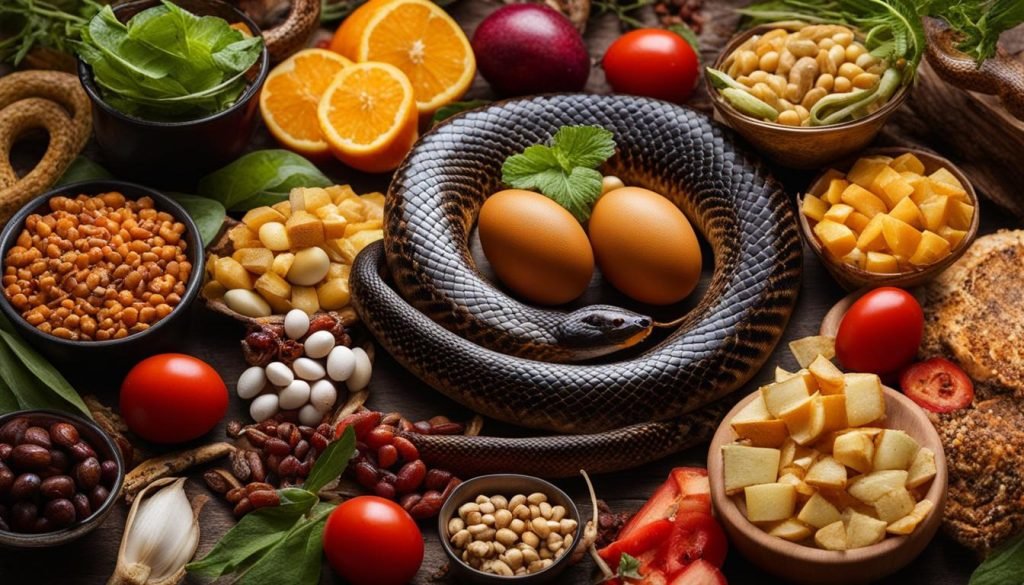
| Snake Species | Food Preferences |
|---|---|
| Ball Python | Small mammals, such as mice and rats |
| Green Tree Python | Small mammals, such as rats and mice; birds and their eggs |
| King Cobra | Other snakes, lizards, rodents |
| Garter Snake | Fish, amphibians, earthworms, insects |
Snake Prey and Adaptations
Snakes have evolved incredible adaptations to capture and consume their prey, which can vary widely depending on the species. Some snakes, such as the common garter snake, primarily feed on small amphibians and invertebrates, while others, such as the king cobra, prefer larger prey like rodents and other snakes.
One of the most well-known adaptations of snakes is the ability of venomous species to inject their prey with toxic venom. The venom acts as a paralytic, making it easier for the snake to capture and consume its prey. Other species of snake, such as constrictors, use their powerful bodies to suffocate and crush their prey.
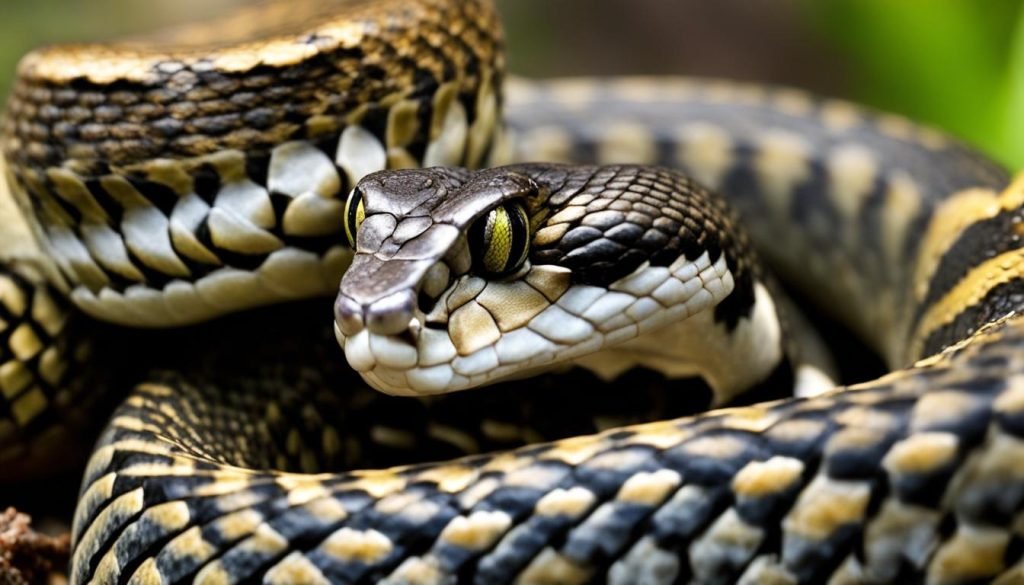
Snakes have also developed specialized hunting techniques to capture their prey. For example, some species, such as the hognose snake, use their sense of smell to locate their prey, while others, such as the rattlesnake, rely on their heat-sensing abilities to track down warm-blooded prey.
| Species | Prey | Adaptation |
|---|---|---|
| King Cobra | Rodents, other snakes, birds | Venom injection |
| Common Garter Snake | Small amphibians, invertebrates | N/A |
| Boa Constrictor | Rodents, birds, other small mammals | Constriction |
| Rattlesnake | Small mammals, lizards | Heat-sensing abilities |
Overall, the adaptations of snakes allow them to capture a wide range of prey and survive in different environments. Their unique features and behavior have contributed to their success as predators for millions of years.
Snake Feeding Process
Have you ever wondered how snakes locate and catch their prey? Snake-feeding behavior is an intricate process that involves both physical and chemical adaptations.
Snakes use their sense of smell to detect potential prey, and some species can even sense heat using special organs called pit organs. Once a snake has found a meal, it will strike and grab the prey with its sharp teeth.
Next comes the physical process of swallowing the food. Snakes use their flexible jaws to stretch open their mouths wide enough to engulf the entire prey item. Some snakes, such as constrictors, will then use their powerful muscles to squeeze and suffocate their prey, while others, such as venomous snakes, rely on their venom to immobilize the prey.
Finally, the digestive process begins. Snakes have a unique digestive system that allows them to consume large meals. Their stomachs are highly elastic and can expand to accommodate prey items that are much larger than the size of their heads.
It can take several days to several weeks for a snake to digest a meal, depending on the size and type of food consumed. During this time, the snake’s metabolism increases significantly, and they will not need to eat again until the meal has been fully digested.
Snake Diets in Captivity
As with any animal, it’s essential to provide snakes with appropriate diets to keep them healthy in captivity. Fortunately, many snakes readily adapt to captive feeding.
The first step in determining an appropriate diet for your snake is to identify the species. Different snakes have different feeding habits and requirements. For example, while some species, such as ball pythons, survive on a diet of rodents alone, others, such as king snakes, benefit from a varied diet that includes amphibians and reptiles.
It’s crucial to research the dietary needs of your particular snake to ensure that you’re providing the right nutrients. In general, snakes in captivity should be fed pre-killed prey, usually purchased frozen from pet stores. Feeding live prey carries a risk of injury to the snake.
A common mistake novice snake owners make is overfeeding. Snakes in the wild can go weeks or even months without eating, depending on the species. In captivity, it’s essential to establish a feeding schedule that doesn’t overfeed or underfeed your snake. Overfeeding can lead to obesity and health problems, while underfeeding can result in malnourishment and illness.
Another factor to consider when feeding snakes in captivity is their age and size. Young snakes require more frequent feedings than adults, and their prey should be smaller to prevent digestive issues. As snakes grow, the size and frequency of their food should also increase to accommodate their changing dietary needs.
Finally, it’s essential to observe your snake’s eating habits to ensure that they are healthy and thriving. Any changes in appetite, digestion, or behavior should be noted and discussed with a veterinarian or experienced snake owner.
In conclusion, providing the right diet for your snake is vital to their health and well-being in captivity. By researching their dietary needs, establishing a feeding schedule, and monitoring their eating habits, you can ensure that your snake thrives in captivity.
Conclusion: An Appreciation for Snakes’ Diets
As we come to the end of this article, I hope you have gained a new appreciation for the diets of snakes. From their diverse food preferences to their remarkable adaptations for capturing and consuming prey, snakes are fascinating creatures with unique feeding habits.
Understanding snake diets also allows us to recognize the vital role they play in maintaining the balance of ecosystems worldwide. Snakes are powerful predators that help control populations of rodents and other small animals. Without snakes, the delicate balance of nature would be disrupted.
The Importance of Proper Snake Diets
Whether in the wild or in captivity, providing snakes with appropriate diets is crucial for their health and well-being. In captivity, it’s essential to understand the specific dietary needs of different snake species and to provide a varied and nutritious diet. This ensures that snakes receive the necessary nutrients and vitamins for good health.
More About Snakes:
- How Do Snakes Mate? Snakes Mating Explained
- How Long Do Snakes Live?
- 15 Facts About Snakes You Didn’t Know
- Snake Quiz: How Well Do You Know Snakes?
Frequently Asked Questions
What do snakes eat?
Snakes eat a variety of prey depending on their species and habitat. Their diet can include rodents, birds, amphibians, and even other snakes.
What are the feeding habits of snakes in the wild?
Snakes in the wild have diverse feeding habits. They employ various strategies to capture their prey and consume a wide range of food to sustain themselves.
What are the food preferences of snakes?
Snakes exhibit different food preferences. They commonly consume rodents, birds, amphibians, and other snakes, playing an important role in the ecosystem.
How do snakes capture and consume their prey?
Snakes have evolved remarkable adaptations for hunting. They use specialized techniques like constriction or venom to capture and consume their prey.
What is the feeding process of snakes?
The feeding process of snakes involves locating and catching prey, followed by the physical process of swallowing and digesting food.
What should be the diet of snakes kept in captivity?
The diet of captive snakes varies based on their species. It is important to provide appropriate types of food and establish a feeding schedule that ensures their health and well-being.
Why is understanding snake diets important?
Understanding what snakes eat helps us appreciate their vital role in maintaining the balance of ecosystems. Their diverse diets contribute to the interconnectedness of nature’s web of life.




